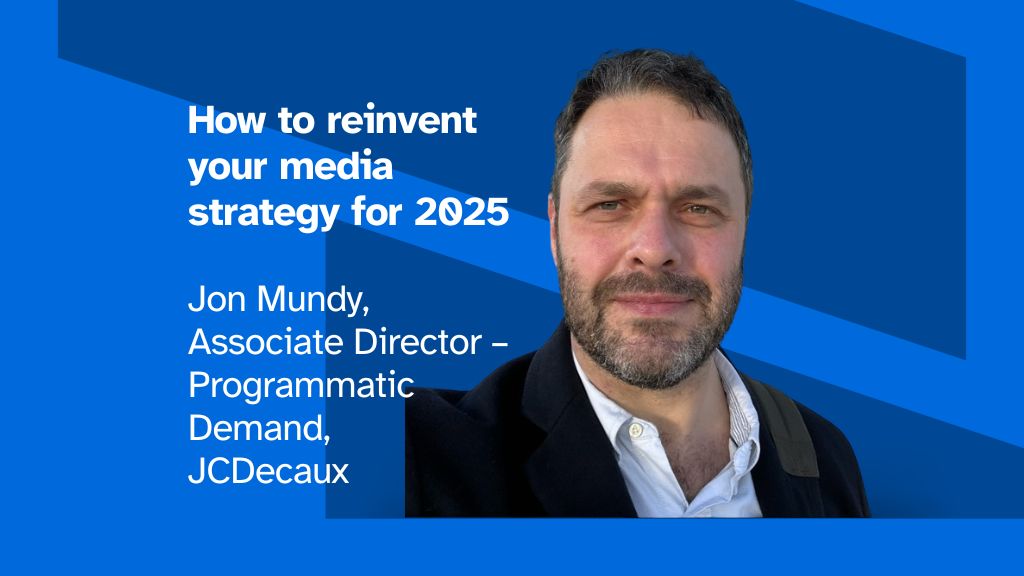by Jon Mundy, Associate Director – Programmatic Demand, JCDecaux
We live and work in a world that changes rapidly and unpredictably. For marketing to be effective, planners and buyers must be agile, responsive to new trends and emerging technologies, and embrace a forward-thinking approach to media planning. Failure to adopt this mindset and defaulting to copy-and-paste media planning hoping that what worked in previous years will continue to deliver results is naive and results in missed opportunities to engage consumers and deliver business outcomes.
Creating and maintaining an agile approach to media strategy will result in more personalised, efficient, and measurable campaigns. Here are three steps marketers can take to reinvent their media strategy for increased success.
Fresh audience insights should lead all media planning
The emphasis on individual identifiers, data, and technology in advertising has led to great innovation but also a lot of bad practice and misunderstanding. If marketers are to eliminate wastage and maximise returns, they must put fresh audience insights front and center of all media planning. Assuming that your target audience engages with media in the same way they have done in the past is the enemy of good media planning.
Many planners and buyers still opt for basic demographic targeting or rely too much on walled gardens and off the shelf targeting options. This can lead to sub-optimal distribution of budget across channels and wasted ad spending on low quality media.
Buyers should seek audience insights from a variety of sources and interrogate the quality, recency, and accuracy of all data sets at their disposal. They should also ensure that the audience insights used in planning can be linked to the metrics that will be used to evaluate the success of the campaign.
It is also vital to consider the overall campaign from an omnichannel perspective. Questions buyers should be asking at this stage include: are the insights being used to decide on the media mix giving you a fair comparison of all channels available? Are the metrics proposed for measurement applicable and comparable across all channels? If the answer to either question is ‘no’, you risk an unbalanced and inefficient media mix and biased measurement that doesn’t paint the full picture of success.
Emphasise relevance and personalisation
Once you have a good understanding of which channels will be most effective in reaching your target audience you should think about how you can tailor the creative to maximise relevance and personalisation within each channel. Data and AI can be useful tools to tailor messaging to audience preferences, interests, and behaviours in all channels.
When considering how to emphasise relevance and personalisation in pDOOH, it’s important to bear in mind that it is a one-to-many channel rather than a one-to-one channel. This doesn’t mean lower relevance or less personalisation, it simply means that you need to think differently about these things.
Dynamic creative optimisation (DCO) in pDOOH leverages consumer, market, or contextual data to adjust creative in real-time. Geofencing and proximity-based targeting enable you to serve more relevant ads when a user is in a specific location or environment. Additionally, pDOOH gives buyers the opportunity to optimise campaigns in real-time. Programmatic platforms can automatically adjust bids, audiences, and creative in real-time based on campaign performance. This helps to continually maximise relevance and improve personalisation and removes the constraints associated with traditional, longer-term routes to market.
Focus on business outcomes and attribution modelling
Modern media planning should balance long-term brand-building strategies and short-term performance-driven campaigns. Ensure your overall campaign strategy and media mix support both objectives and integrate strategies that boost brand affinity and conversions.
Sustaining an appropriate level of reach across the year can help maintain buyers’ mental availability and drive long-term growth. Maximising cumulative reach across your target audience should remain a key objective regardless of short-term goals that may exist in individual campaign briefs. Out of home is a great way to do this and programmatic activation can help buyers to increase efficiency when looking for mass reach by providing solutions that optimise CPMs, target audience reach, and frequency across channels.
Incorporating performance-based metrics is critical when investing in omnichannel media campaigns. Buyers need to work to ensure that they are not relying on traditional metrics such as impressions or GRPs and instead focus on more relevant KPIs that reflect actual performance and are applicable across all channels. Examples include return on investment (ROI), online and offline sales, footfall, cost per acquisition, and customer lifetime value.
In tandem with ensuring performance metrics are up-to-date, marketers should actively seek out more sophisticated, multi-touch attribution models to better understand the true impact of each media touchpoint in the customer journey. This allows for smarter media budget allocation and helps optimise your media mix on a continual basis.
For brands that sell products or services both online and offline, investing in technologies that allow you to track both online and offline actions that result from media exposure will provide a clearer understanding of how your media plans are influencing real-world behaviors.
Key priorities for 2025
Today, effective media planning requires an agile, collaborative approach and the most effective campaign planning includes media strategists, data analysts, and creative teams. Combining these three functions ensures that audience targeting is as precise as possible, messaging is in sync with targeting strategies, and the media mix is continually optimised. Many agencies and in-house planning teams also find it useful to collaborate with media owners who also sit on a wealth of audience data that can help refine the planning process.
In an era of constant change, testing different media tactics, ad creatives, targeting approaches, and even ad formats is crucial to learning what works best. Use A/B testing and experimentation to optimise your media strategy and improve campaign results.
Adopt a more agile approach to media planning where you’re able to adjust campaigns quickly based on real-time data. This allows you to capitalise on emerging trends, address issues before they become problems, and respond to shifts in consumer behavior.
Finally, balancing real-time decision-making with long-term strategic goals, embracing new media formats, and fostering collaboration across teams will allow you to stay relevant in a constantly evolving advertising landscape.










